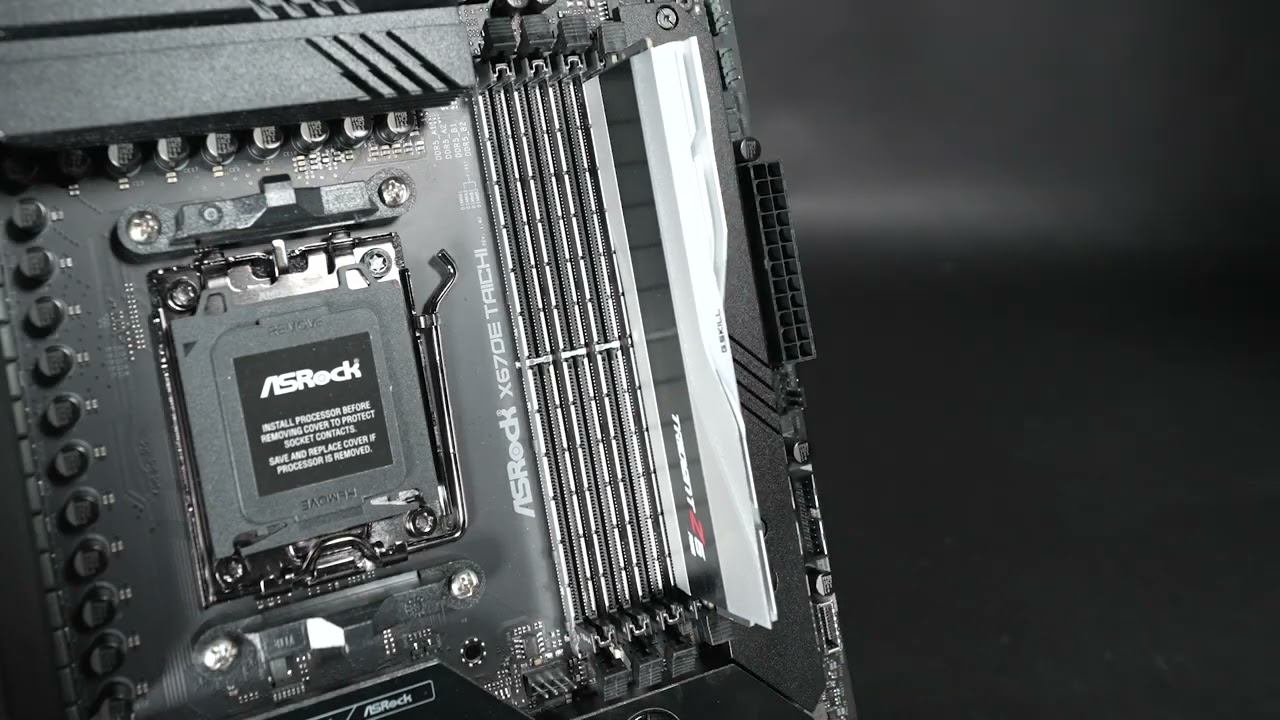ASRock attributes premature Ryzen 9000 CPU failures to aggressive PBO settings, per YouTuber
ASRock alleges that these problems have been fixed with their latest BIOS release.

A common thread among increasing user reports of failing Ryzen 9000 CPUs was their connection to an ASRock AM5 motherboard. Citing a conversation with the partner at Computex, Tech Yes City has brought to light that ASRock's initial PBO (Precision Boost Overdrive) presets were set too aggressively for initial CPU samples. It is believed these aggressive settings are what ultimately lead to the premature demise of these processors. AMD declined to comment on the story, while ASRock wasn't immediately available.
Earlier this year, reports of failing AMD Ryzen 9000 (Granite Ridge) processors were common on Reddit and other forums. ASRock initially dismissed reports connecting their motherboards to the problem as 'misinformation', all the while supplying a new BIOS to address boot-up and memory compatibility issues. Affected users had no other choice but to RMA their broken CPUs.
According to new details from Tech Yes City, the problem stems from the amperage (current) supplied to the processor under AMD's PBO technology. Precision Boost Overdrive employs an algorithm that dynamically adjusts clock speeds for peak performance, based on factors like temperature, power, current, and workload. The issue is reportedly confined to ASRock's high-end and mid-range boards, as they were tuned far too aggressively for Ryzen 9000 CPUs.
ASRock believes their settings for the Electric Design Current (EDC) and Thermal Design Current (TDC) were set overly high for early CPU samples. Does this imply initial silicon was less stable than what we're getting now? It's hard to say. ASRock reportedly ruled out memory incompatibility and excessive SoC voltages as potential causes, the latter of which has a history of wrecking last-generation Ryzen 7000 (Raphael) CPUs.
Liquid coolers and AIOs are said to compound this problem, as they provide greater thermal headroom for PBO. Per the YouTuber, ASRock has fixed this issue with a new BIOS update. While preliminary testing reveals no difference in EDC and TDC values, ASRock has also reportedly reduced "shadow voltages," which are settings not visible to users.
It's still uncertain if the fault lies with AMD or ASRock, as all partners are bound by specific and clear limits set by AMD. Likewise, it is too soon to tell if this fix is truly effective, but we'll know for sure if more cases surface. Questions also emerge from ASRock's media representative initially dismissing user reports as 'misinformation'. It's unlikely to be a coincidence when reports of the same issue point to motherboards from one specific manufacturer. While we've requested further comment on the matter, ASRock should release a public advisory urging users to update their BIOS to prevent potential failures, if that indeed is the necessary fix.
Follow Tom's Hardware on Google News to get our up-to-date news, analysis, and reviews in your feeds. Make sure to click the Follow button.
Stay On the Cutting Edge: Get the Tom's Hardware Newsletter
Get Tom's Hardware's best news and in-depth reviews, straight to your inbox.

Hassam Nasir is a die-hard hardware enthusiast with years of experience as a tech editor and writer, focusing on detailed CPU comparisons and general hardware news. When he’s not working, you’ll find him bending tubes for his ever-evolving custom water-loop gaming rig or benchmarking the latest CPUs and GPUs just for fun.
-
A Stoner These are complicated systems, but you have to wonder how so many errors have been happening in computing. Particularly with respect to overpowering the CPUs to the point of failure. Intel had a huge issue here, and now AMD. Don't these people read the literature of their own business and take lessons learned?Reply -
redgarl Reply
This is the AIBs fault. They are pushing for obtaining the performance crown at the expense of safe power distribution.A Stoner said:These are complicated systems, but you have to wonder how so many errors have been happening in computing. Particularly with respect to overpowering the CPUs to the point of failure. Intel had a huge issue here, and now AMD. Don't these people read the literature of their own business and take lessons learned?
Since more than 90% of the cases are reported with Asrock hardware, it is obviously an Asrock problem. AIBs are really quick to point fingers and deny they are responsible when, most of the time, their BIOS are the issue.
This is totally different from Intel which literally choose to push the voltages on their CPU to be able to compete with AMD and TSMC. -
derekullo "ASRock has also reportedly reduced "shadow voltages," which are settings not visible to users."Reply
Reduced "shadow voltages" isn't exactly a vote of confidence! -
UnforcedERROR Reply
These are not comparable. Intel's was their design. AMD's was the result of a motherboard manufacturer. AMD had no issues with other vendors, so it's not something they caused.A Stoner said:Intel had a huge issue here, and now AMD. -
thestryker I mostly just wonder if this is like the overly aggressive SoC voltage which happened pre-Zen 5. That was mostly being exploited by Asus and had just been a setting AMD neglected to hard limit. These things happen and hopefully this is indeed the final resolution for this issue.Reply -
Notton Ah, so exactly as I suspected when it was something like 50~80% of Asrock mobos with Sudden Ryzen Death Syndrome. (If anyone remembers Northwood SNDS) Except now the mobo manufacturer does it, rather than something you can only cause by yourself.Reply -
HardwiredWireless ReplyUnforcedERROR said:These are not comparable. Intel's was their design. AMD's was the result of a motherboard manufacturer. AMD had no issues with other vendors, so it's not something they caused.
UnforcedERROR said:Right, it would obviously be the fault of whoever it was that provided the specifications to the motherboard manufacturers for the AMD CPUs. -
EzzyB Reply
Did they? I see it differently.A Stoner said:These are complicated systems, but you have to wonder how so many errors have been happening in computing. Particularly with respect to overpowering the CPUs to the point of failure. Intel had a huge issue here, and now AMD. Don't these people read the literature of their own business and take lessons learned?
I go back to building my current PC. It's based on a 9700K and a Gigabyte Motherboard. That processor is advertised as running at 3.6 GHZ with a boost of up to two cores to 4.8 GHZ. I assembled it and booted it up for the first time. With NO user intervention it booted up with all 8 cores at 4.7 GHZ and all cores would boost to 5GHZ.
If something happens, is that Intel's fault? I don't think so. It's fine, it's actually been running at all-core 4.9 GHZ for five years now with no issues whatsoever (one blue screen after a week when I tried 5 GHZ so I dialed it back a notch.) Still, I wouldn't feel it was Intel's fault if that first boot had crashed. -
YSCCC Reply
I wonder what's the shadow voltage and it's value...derekullo said:"ASRock has also reportedly reduced "shadow voltages," which are settings not visible to users."
Reduced "shadow voltages" isn't exactly a vote of confidence! -
abufrejoval I used to buy quite a bit of stuff from ASRock, first purchase trace I could find was a 939 Dual VSTA from 2006, which offered the ability to upgrade from an AMD K8 939 socket to a AM2 940 one. Which I also did and that system might actually still running today (don't ask). It could have been the essential step to AMD64 64-bit, which I absolutely couldn't miss, but not afford a new system for.... I'd have to check.Reply
I liked them precisely because they were always extra createive, they'd alway play a little loose with the vendor imposed limitations.
E.g. they'd simply ignore the official RAM limits Intel imposed on their Atoms, ASRock Mini-ITX Atom boards would always support as much RAM as the hardware could, so DDR3 with 16GB and DDR4 with 32 GB when 4/8 GB were officially the maximum supported: other vendors stuck to those limits and that's why I discarded them, because I really wanted those silent Atoms to run quite a few VMs.
They still work btw, 24x7 since 2019...
It's by sheer accident, or lack of stand-out features, that I didn't pick them for most of my builds since then.
And I'd sure hate to be in that spot with a failed or damanged system, because I can't quite imagine them replacing board and CPU today, nor would it be much use when you can't wait ages for a working system.
